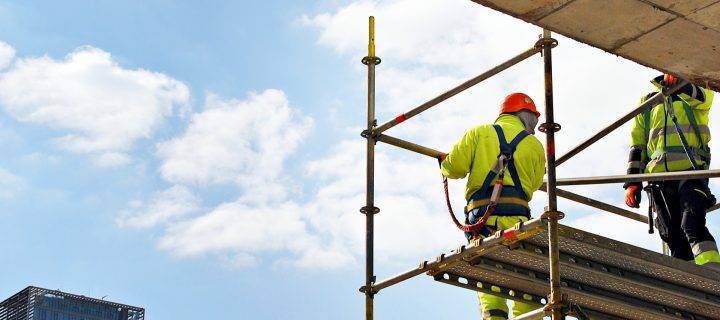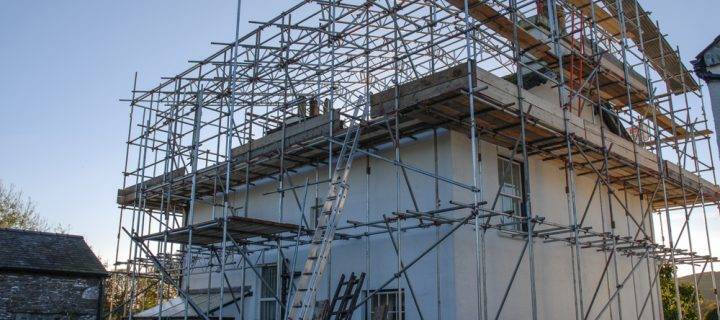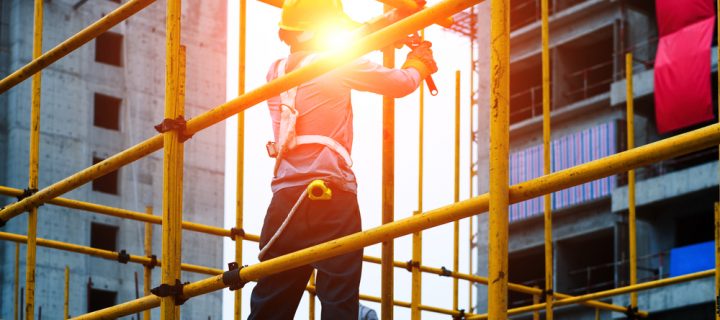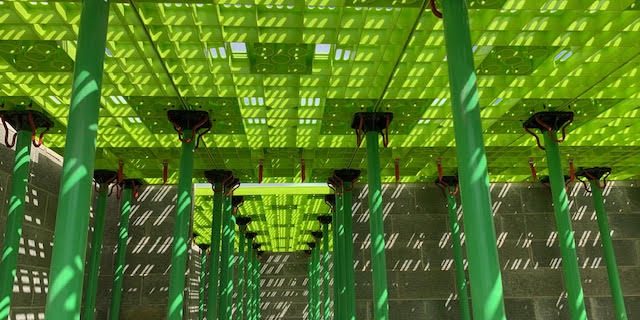Here at Network Scaffold Services, we know all about the best way to work with scaffolding. If you have recently decided to undertake a construction project that requires a scaffold frame, it is important to know as much as possible before you start. For this blog, we will give you five handy tips to ensure your building will be safe and look fantastic once work is completed. Having confidence in your scaffolding structure 1) Plan ahead – Planning ahead makes your job easier and ensures all your equipment to complete the structure is readily available. This means that you will not be missing any important pieces and your structure meets all health and safety legislation. Having a few sketches of the proposed construction allows you to visualise the structure, so when placing orders for materials you will get everything you need. Sketches will also help explain the structure to the scaffold team during a briefing. Planning ahead ensures you have met all necessary requirements plus you will save time and money. 2) Construction ground – The foundations and conditions of the ground when building a scaffold is very important. Construction on uneven ground can be dangerous. Making sure the ground is level means the scaffold can be supportive even when conditions are wet. 3) Safety is a top priority – Safety is our number one priority at Network Scaffold Services. Making absolutely sure structures are safe and stable limits the chances of accidents on-site. Protective equipment such as hard hats, long sleeves, gloves, and goggles need to be worn when working with the scaffold. Protective equipment also needs to be used on scaffolding, such as safety rails and access gates to prevent anyone from falling from a height. 4) Creating a safe structure – Using safety decking gives you a safe working platform. The decking fits tightly together and ensures materials will not fall through the cracks to any other level when in use. Scaffolding also needs to be tied to the property for maximum protection. 5) Inspect scaffold – Scaffolding needs to be thoroughly checked out and inspected before being used. An inspection log has to be completed daily, detailing deterioration or signs of broken or partially damaged...
Read Moreabout 5 Ways to stay safe using scaffoldingFlat roofs, like any other type of roof, do require maintenance to ensure you don’t need to have any repairs completed using scaffolding. Traditionally easier to maintain than a regular roof, flat roofs are asphalt-based and other similar materials. Depending on the quality of the original installation and the continued maintenance, flat roofs can last up to 50 years before they need replacing. Their lifespan is almost as long as tiled roofs, which last for up to 60 years. We would generally recommend checking your roof every spring and autumn, plus after particularly harsh weather, such as storms, strong winds or heavy snowfall. Fixing a flat roof If you discover any splits, blistering or damages, the surface will need properly examining before hiring someone to fix your roof. First, the area will need clearing of any damp or water, but if the surface has split or blistering has occurred it will need repairing. Flat roof repairs for splitting Splitting is quite a common problem for flat roofs, which occurs when the felt or asphalt material covering the roof suffer from cracks or tears. This does not just affect the outer appearance of the roof, plus it also allows water to get in through the gaps and into the interior of your property which results in leaks and damage from damp which can be difficult to fix. Splits in roof material can be caused by a number of things, such as wear and tear from exposure to the elements, stresses on the material, water pooling, freeze-thawing or poor workmanship when it was initially installed. If you have started to notice staining or the beginning signs of dampness on your ceiling or the tops of the walls inside your property underneath a flat roof, this can be a sign of splitting or other damage to the roof that is allowing water to seep in. Ponding on flat roofs Ponding can cause deep concave indents to occur around the roof, with stains and watermarks occurring on the inside of your property. These indents will continue to collect water, damaging material which over time allows water to begin to seep through into your home’s interior. This is usually caused by insufficient drainage, which...
Read Moreabout How to avoid scaffolding for flat roof repairsRecently Network Scaffold Services has expanded its range of products, including plastic hoarding and safety decking for construction projects. Our hoarding is designed for strength, durability, and simplicity which makes it quick and easy to erect, adapt and dismantle. It is also possible to promote your corporate identity on the boards, plus they can be reused for another project in the future. Sustainability benefits Fully reusable and recycle Zero waste to landfill Reduces the carbon footprint of your project 100% recyclable at end of life Commercial and Construction benefits Installation service or training available from our team of installers Quick and easy to erect, adapt and dismantle External and internal applications Where can I use plastic hoarding? Here are some examples of how plastic hoarding can be utilised across different sites – Internal or external shop frontage Ideal for festivals and events needing temporary fencing Hoarding scaffolds and structures Construction and demolition projects Also, suitable for offices, soundproof areas, and hospital sterile areas Why is hoarding so important? Construction sites that use hoarding will keep intruders out plus they will ensure the safety of the general public passing by. The Health and Safety at Work etc Act 1974 and the Construction (Design and Management) Regulations 2015, which were introduced by the HSE’s Construction division state the importance of having secure hoarding around construction sites. Unlike timber construction panels, our plastic panels are water-resistant, which means they do not rot and can be reused; saving you money on standard plywood products. Get in touch for more information If you would like more information about Network Scaffold’s range of plastic hoarding, please do not hesitate to contact us today. Our team of specialists will be more than happy to answer any queries you may have. Don’t forget Network Scaffold also supplies signature scaffolding products such as edge protection, alloy towers plus access scaffold...
Read Moreabout What are the advantages of plastic hoarding?Here at Network Scaffold Services, we work with a number of different types of scaffolding, which are all used for different purposes in construction. For our latest blog, we will talk you through seven different kinds of scaffold available on the market and explain their uses. 7 Different types of scaffolding explained Single – This is commonly known as brick layer’s scaffolding and consists of standards, ledgers, putlogs, which is parallel to the wall at a distance of roughly 1.2m. The distance between the standards is between 2 and 2.5 metres, with ledgers connecting the standards at a vertical interval of 1.2-1.5m. Putlogs are taken out from the hole left in the wall to one end of the ledgers. Putlogs will then be placed at an interval of 1.2-1.5m. Double – Generally used for stone masonry, it is sometimes referred to as mason’s scaffolding. In stone walls, it is difficult to make holes in the wall to support putlogs. Two rows of scaffold will make this strong. Cantilever – This type of system has standards that are supported on a series of needles, that go through holes in the wall. This is known as single frame type scaffolding. For other types, needles are strutted inside the floors through the openings and are known as independent or double frame scaffold. Please note, care needs to be taken when constructing this system. Typically cantilever systems should be used in the following conditions – When the ground doesn’t have the capacity to support standards When the ground near the wall needs to be free from traffic When the upper part of the wall is under construction Suspended – A suspended working platform is based on roofs with the help of wire ropes or chains. This can be raised or lowered to the required level. The system is used for repair works, pointing and paintings. Trestle – For a trestle scaffold platform, it is supported on movable tripods or ladders and is generally used for work inside the room, such as paintings or repairs up to 5 metres in height. Steel – Steel platforms are constructed by steel tubes that are fixed together by steel couplers or fittings. Very easy to construct or...
Read Moreabout What are the different types of scaffolding?Scaffold safety decking has been a widely used component in the construction industry for 20 years. These systems help to prevent falls, with the deck elevated to a position just below the working surface. This original concept has been further developed; with recent systems providing a more rigid and stable working platform using relatively light components, which are easy to erect. Issues that Safety Decking addresses Systems used by Network Scaffold Services are used to combat problems faced by operatives installing roof trusses. These issues include – There is nowhere for them to stand when fixing and bracing trusses Having a satisfactory anchorage point for personal fall arrest equipment is difficult to find The trellis innovation for safety decks protects operatives by providing a temporary work platform. The industry’s standpoint on safety systems has also evolved, with an emphasis on risk control. This includes a heavy lean towards PPE plus the decks being passive collective fall prevention for all operatives working on it. How are these systems manufactured? PVC components for safety decks are manufactured by specialist plastic organisations that use technology for moulding configurations for a number of component shapes. The moulding manufacturing technique provides a number of advantages over other forms of manufacture. As the system components are formed with no requirement for additional cutting of the plastic, which could potentially weaken the component at the cut area. The trellis arrangement is manufactured in aluminium square tubular sections and cut to the required size. Then they are riveted together, forming the extendable trellis. This is the point when the manufacturer’s logo and any further paintwork would be applied. Order your scaffolding systems from Network Scaffold If you are looking for scaffolding systems plus safety decking or even plastic hoarding, Network Scaffold Services is your only destination. We work with domestic and commercial clients across Derby and the surrounding areas; please contact us for more...
Read Moreabout How Safety Decking is constructed?




